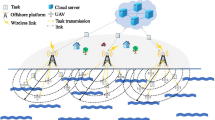Abstract
Modern defense systems are developing towards systematization, intellectualization and automation, which include the collaborative defense system on the sea between multiple unmanned surface vehicles (USVs) and unmanned aerial vehicles (UAVs). UAVs can fly in high altitude and collect marine environment information on patrolling. Furthermore, UAVs can plan defense paths for USVs to intercept intruders with full-assignment or reassignment strategies aiming at maximum overall benefits. Thus, we propose dynamic overlay reconnaissance algorithm based on genetic idea (GI-DORA) to solve the problem of multi-UAV multi-station reconnaissance. Moreover, we develop continuous particle swarm optimization based on obstacle dimension (OD-CPSO) to optimize defense path of USVs to intercept intruders. In addition, under the designed defense constraints, we propose dispersed particle swarm optimization based on mutation and crossover (MC-DPSO) and real-time batch assignment algorithm (RTBA) in emergency for formulating combat defense mission assignment strategy in different scenarios. Finally, we illustrate the feasibility and effectiveness of the proposed methods.
Similar content being viewed by others
References
CAO D S, SANG L Z. Key technologies of maritime distress search and rescue based on unmanned aerial vehicle [J]. Transport Research, 2017, 3(3): 62–67 (in Chinese).
WANG H L, WU G H, MA M H. Coordinated task planning method of multiple heterogeneous earth-observation platforms [J]. Acta Aeronautica et Astronautica Sinica, 2016, 37(3): 997–1014 (in Chinese).
WANG H L, XIAO B, WU J, et al. A collaborative scheduling-based parallel solution for HEVC encoding on multicore platforms [J]. IEEE Transactions on Multimedia, 2018, 20(11): 2935–2948.
AGHAEEYAN A, ABDOLLAHI F, TALEBI H A. Robust cooperative control in the presence of obstacles [C]// 21st Iranian Conference on Electrical Engineering. Mashhad: IEEE, 2013: 1–6.
AGHAEEYAN A, ABDOLLAHI F, TALEBI H A. UAV-UGVs cooperation: With a moving center based trajectory [J]. Robotics and Autonomous Systems, 2015, 63: 1–9.
KAMEL M A, GHAMRY K A, ZHANG Y M. Fault tolerant cooperative control of multiple UAVs-UGVs under actuator faults [C]// 2015 International Conference on Unmanned Aircraft Systems. Denver, CO: IEEE, 2015: 644–649
KAMEL M A, GHAMRY K A, ZHANG Y M. Real-time fault-tolerant cooperative control of multiple UAVs-UGVs in the presence of actuator faults [J]. Journal of Intelligent & Robotic Systems, 2016, 88(2/3/4): 469–480.
ZHANG J M, XIONG J F, ZHANG G Y, et al. Flooding disaster oriented USV & UAV system development & demonstration [C]// OCEANS 2016-Shanghai. Shanghai: IEEE, 2016: 1–4.
DUFEK J, MURPHY R. Visual pose estimation of USV from UAV to assist drowning victims recovery [C]// 14th International Symposium on Safety, Security and Rescue Robotics. Lausanne: IEEE, 2016: 147–153.
SHI W R, HUANG X H, ZHOU W. Path planning of mobile robot based on improved artificial potential field [J]. Journal of Computer Applications, 2010, 30(8): 2021–2023 (in Chinese).
SABRI A N, RADZI N H M, SAMAH A A. A study on bee algorithm and A* algorithm for path finding in games [C]// 2018 IEEE Symposium on Computer Applications and Industrial Electronics. Penang Island: IEEE, 2018: 224–229.
HUANG Y K. An improved shortest path algorithm based on Dijkstra for indoor mobile navigation [J]. Journal of Fujian Normal University (Natural Science Edition), 2017, 33(3): 13–18 (in Chinese).
LI H A, PENG Y Z, DENG C Y, et al. Review of hybrids of GA and PSO [J]. Computer Engineering and Applications, 2018, 54(2): 20–28 (in Chinese).
GUO S L, SUN H Y, CHEN Z. Path planning method for mobile robot based on improved genetic algorithm [J]. Electronics World, 2017 (6): 18–19 (in Chinese).
LI W, WU W J, WANG H M, et al. Crowd intelligence in AI 2.0 era [J]. Frontiers of Information Technology & Electronic Engineering, 2017, 18(1): 15–43.
GUO Y, WANG W H, WU S T. Research on robot path planning based on fuzzy neural network and particle swarm optimization [C]// 29th Chinese Control and Decision Conference. Chongqing: IEEE, 2017: 2146–2150.
HUANG J, CHEN M, JIANG C S. Satisficing decision-making on task allocation for UAVs in air-to-ground attacking [J]. Electronics Optics & Control, 2014, 21(7): 10–13 (in Chinese).
XIONG S, YANG Y Q, NI M F. A new generalized assignment problem model and its method [J]. Advances in Computer Science Research, 2017, 54: 749–755.
LIANG Y S, WAN Z P, FANG D B. An improved artificial bee colony algorithm for solving constrained optimization problems [J]. International Journal of Machine Learning & Cybernetics, 2017, 8(3): 1–16.
LI M, LIU W, ZHANG Y D. Mulit-agent dynamic task allocation based on improved contract net protocol [J]. Journal of Shandong University (Engineeing Science), 2016, 46(2): 51–56 (in Chinese).
WU J C, ZHOU R, RAN H M, et al. Performance comparison of genetic algorithm with auction algorithm in task allocation [J]. Electronics Optics & Control, 2016, 23(2): 11–15 (in Chinese).
Author information
Authors and Affiliations
Corresponding author
Additional information
Foundation item: The National Natural Science Foundation of China (No. 61625304)
Rights and permissions
About this article
Cite this article
Wu, X., Liu, Y., Xie, S. et al. Collaborative Defense with Multiple USVs and UAVs Based on Swarm Intelligence. J. Shanghai Jiaotong Univ. (Sci.) 25, 51–56 (2020). https://doi.org/10.1007/s12204-019-2142-y
Received:
Published:
Issue Date:
DOI: https://doi.org/10.1007/s12204-019-2142-y
Key words
- collaborative defense
- mission assignment
- path planning
- unmanned surface vehicles (USVs)
- unmanned aerial vehicles (UAVs)




